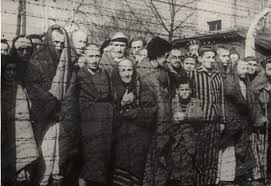“The Holocaust” – Everything You Need to Know
The Holocaust remains one of the darkest chapters in human history—a systematic, state-sponsored genocide that claimed the lives of six million Jews and millions of others deemed “undesirable” by the Nazi regime. Its impact on survivors, subsequent generations, and global society is immeasurable. In this comprehensive guide on The Holocaust, we’ll delve into its origins, defining characteristics, major events, and lasting effects. Whether you’re a student of history, an educator, or simply someone seeking to understand the significance of this tragedy, this article provides a thorough exploration of why the Holocaust is essential to remember—and how its lessons continue to shape our world today.
Introduction: Remembering a Catastrophe That Changed the World
Imagine a society where a government systematically dehumanizes an entire people, stripping them of their rights, dignity, and lives. Did you know that during the Holocaust, six million Jews were murdered, along with millions of others including Romani people, disabled individuals, political dissidents, and more? This shocking fact underscores the magnitude of the atrocities committed during this period.
In this post on The Holocaust, we will cover:
- Definition & Core Characteristics: What the Holocaust was and the key features that defined this genocide.
- Historical Background: The events and conditions that led to the rise of Nazism and the systematic persecution of millions.
- In-Depth Exploration: A detailed examination of the methods, events, and human experiences during the Holocaust, supported by real-world examples and survivor testimonies.
- Impact and Legacy: How the Holocaust reshaped global politics, human rights, and cultural memory.
- Common Misconceptions & FAQs: Clarifying persistent myths and misunderstandings about the Holocaust.
- Modern Relevance: Exploring how the lessons of the Holocaust continue to influence education, international policy, and social justice.
- Call-to-Action: Encouraging further reading, reflection, and active remembrance of this pivotal event in history.
Understanding The Holocaust is crucial for ensuring that such atrocities are never repeated. By examining its causes, execution, and consequences, we can honor the memory of those who suffered and reinforce our commitment to human dignity, justice, and peace.
What Is “The Holocaust”?
Defining the Concept
The Holocaust refers to the systematic, bureaucratic, state-sponsored persecution and murder of six million Jews, as well as millions of others—including Romani people, disabled individuals, Slavic peoples, political dissidents, and various minority groups—by Nazi Germany and its collaborators between 1941 and 1945. Its essential characteristics include:
State-Sponsored Genocide:
The Holocaust was not a spontaneous outburst of violence but a meticulously planned and executed policy orchestrated by the Nazi leadership.Systematic Persecution:
Jews and other targeted groups were subjected to a range of oppressive measures, including discriminatory laws, forced relocation, and ultimately, mass murder in concentration and extermination camps.Bureaucratic Efficiency:
The genocide was carried out with a chilling level of organization, involving detailed record-keeping, specialized administrative procedures, and the coordinated efforts of multiple government agencies.Ideological Justification:
Nazi ideology, based on a warped interpretation of racial purity and anti-Semitism, provided the foundation for the Holocaust. Propaganda played a key role in dehumanizing victims and rallying public support for these policies.Global Impact:
The Holocaust had a profound effect on global history, influencing post-war international law, human rights initiatives, and collective memory around the world.
This definition sets the stage for a deeper exploration of The Holocaust—an event that remains a stark reminder of the dangers of unchecked hatred and authoritarianism.
Historical and Contextual Background
The Origins and Build-Up
The roots of The Holocaust are embedded in a complex historical context that includes long-standing anti-Semitic traditions, the rise of Nazism, and the tumultuous conditions of interwar Europe.
1. Long-Standing Anti-Semitism
Historical Prejudices:
Anti-Semitism in Europe has deep historical roots, with discriminatory attitudes and policies present for centuries. Religious, economic, and cultural factors contributed to widespread mistrust and hostility toward Jews.Medieval and Modern Prejudices:
Over time, these prejudices evolved and were exacerbated by social and economic changes, laying the ideological groundwork for the extreme anti-Semitism propagated by the Nazis.
2. The Rise of the Nazi Party
Economic and Political Instability:
The aftermath of World War I left Germany economically devastated and politically unstable. The harsh conditions imposed by the Treaty of Versailles, along with the economic hardships of the interwar period, created fertile ground for extremist ideologies.Hitler’s Ideology:
Adolf Hitler and the Nazi Party capitalized on these conditions by promoting a virulent ideology based on Aryan supremacy, anti-Semitism, and nationalism. Hitler’s rise to power in 1933 marked the beginning of a systematic campaign to “purify” German society.Propaganda and Control:
Through sophisticated propaganda and the suppression of dissent, the Nazis were able to consolidate power and implement their policies with ruthless efficiency.
3. The Path to Genocide
Escalating Persecution:
From the early discriminatory laws of the 1930s to the establishment of ghettos and the invasion of Poland in 1939, the persecution of Jews and other groups escalated steadily.The “Final Solution”:
In 1941, the Nazi regime adopted the “Final Solution”—a systematic plan to exterminate the Jewish population of Europe. This policy led to the establishment of extermination camps and the mass murder of millions.Historical Anecdotes:
The Wannsee Conference of January 1942, where senior Nazi officials formalized plans for the genocide, is one of the most chilling examples of how bureaucratic efficiency was harnessed for mass murder.
In-Depth Exploration / Main Body
To fully understand The Holocaust, we need to examine its various dimensions: the ideologies that fueled it, the mechanisms by which it was implemented, its human impact, and its enduring legacy. The following sections break down these elements in detail.
1. Ideological Foundations
a. Nazi Ideology and Anti-Semitism
Core Beliefs:
Nazi ideology was built on the belief in racial purity and the superiority of the “Aryan” race. Central to this was a deep-seated anti-Semitism, which portrayed Jews as the root of all societal ills.Propaganda Mechanisms:
The regime used films, posters, and rallies to spread anti-Semitic propaganda. This dehumanization of Jews was crucial in preparing the public for the atrocities that were to come.Intellectual Influences:
Influential texts and pseudoscientific theories were employed to legitimize Nazi policies. These works created a distorted view of history and biology that justified the systematic persecution of millions.
b. Totalitarian Control
Centralized Authority:
The Nazi state exercised absolute control over every aspect of life, from politics and economics to culture and education. This totalitarian grip was maintained through a network of secret police, censorship, and indoctrination.Suppression of Dissent:
Political opponents, intellectuals, and members of minority groups were systematically silenced through imprisonment, torture, and murder. The suppression of dissent ensured that the Nazi ideology could flourish unchecked.Example:
The Night of the Long Knives in 1934, when Hitler purged the leadership of the SA (Sturmabteilung) and other potential rivals, exemplifies the ruthless methods used to maintain totalitarian control.
2. Mechanisms of Persecution and Genocide
a. Legal and Administrative Measures
Discriminatory Legislation:
Laws such as the Nuremberg Laws of 1935 institutionalized racism by legally defining who was considered Jewish and stripping Jews of their rights as citizens.Bureaucratic Efficiency:
The Nazis established an elaborate administrative apparatus to implement their policies, from the registration of Jewish citizens to the operation of ghettos and concentration camps.Case Study – The Nuremberg Laws:
These laws codified racial discrimination, segregating Jews from the rest of society and laying the legal groundwork for further persecution.
b. Ghettoization and Deportation
Creation of Ghettos:
In occupied territories, Jews were forcibly relocated into overcrowded, isolated urban districts known as ghettos. These areas were designed to contain and control the Jewish population.Deportation to Concentration and Extermination Camps:
From the ghettos, Jews and other targeted groups were deported to concentration and extermination camps, where mass murder was carried out with chilling efficiency.Real-World Example:
The ghettos of Warsaw and Łódź in Poland became infamous for their deplorable living conditions and the systematic, industrial-scale extermination that followed.
c. The Role of Technology and Logistics
Industrialization of Death:
The Holocaust was characterized by the use of modern technology to facilitate mass murder. The use of gas chambers, crematoria, and rail transport allowed the Nazi regime to execute its genocidal plans on an unprecedented scale.Efficiency and Scale:
The logistical organization of the Holocaust is a testament to the perverse efficiency of the Nazi bureaucracy. Detailed records, scheduling, and coordination ensured that the process of extermination was carried out with systematic precision.Impact:
The industrial methods employed during the Holocaust transformed mass murder into a mechanized process, making it one of the most horrifying examples of state-sponsored violence in history.
3. The Human Impact
a. The Scale of Human Suffering
Casualty Figures:
Approximately six million Jews were murdered during the Holocaust, along with millions of others, including Romani people, disabled individuals, political dissidents, and various minority groups.Survivor Stories:
The personal testimonies of survivors provide a poignant reminder of the human cost of the Holocaust. Their stories of loss, resilience, and hope are vital for understanding the full scope of the tragedy.Legacy of Trauma:
The psychological and emotional scars of the Holocaust have been passed down through generations, affecting individuals, families, and entire communities.
b. The Impact on Society and Culture
Cultural Destruction:
The Holocaust led to the near destruction of Jewish communities across Europe. Rich cultural traditions, intellectual achievements, and vibrant social networks were decimated.Post-War Reconstruction:
The aftermath of the Holocaust spurred significant efforts to rebuild Jewish communities and preserve the memory of those lost. Institutions like the United States Holocaust Memorial Museum and Yad Vashem in Israel play a critical role in education and remembrance.Influence on Art and Literature:
The Holocaust has profoundly influenced cultural expression. Works such as Elie Wiesel’s Night and films like Schindler’s List ensure that the memory of the atrocities is not forgotten and serve as powerful reminders of the need for vigilance against hatred and intolerance.
4. Global Impact and Long-Term Consequences
a. Redefining International Law and Human Rights
War Crimes Trials:
In the aftermath of World War II, the Nuremberg Trials set a precedent for prosecuting war crimes and crimes against humanity. These trials established important legal principles and accountability mechanisms for state-sponsored atrocities.Universal Declaration of Human Rights:
The horrors of the Holocaust were a driving force behind the creation of the Universal Declaration of Human Rights in 1948, which sought to establish a global framework for protecting individual rights and preventing future atrocities.Legacy:
The legal and moral frameworks developed in response to the Holocaust continue to shape international human rights law and efforts to promote justice and accountability worldwide.
b. Influence on Global Politics and International Relations
Cold War Dynamics:
The Holocaust, along with the broader experiences of World War II, played a crucial role in shaping the post-war international order. The emergence of the United States and the Soviet Union as superpowers, and the ensuing Cold War, were influenced by the need to prevent future genocides and conflicts.Formation of International Organizations:
Institutions such as the United Nations were established to promote international cooperation and prevent the kind of widespread atrocities seen during the Holocaust.Modern Diplomacy:
The legacy of the Holocaust continues to inform global diplomacy, particularly in efforts to combat genocide, hate crimes, and intolerance in today’s interconnected world.
c. Cultural and Educational Legacies
Remembrance and Memorialization:
The Holocaust is remembered through numerous memorials, museums, and educational programs around the world. These efforts aim to preserve the memory of the victims and educate future generations about the dangers of hatred and intolerance.Impact on Modern Culture:
The cultural narrative of the Holocaust influences contemporary art, literature, and public discourse. It serves as a powerful reminder of the consequences of unchecked bigotry and authoritarianism.
Importance, Applications, and Benefits
Understanding The Holocaust is crucial for many reasons, with far-reaching implications across various domains:
a. Informing Modern Policy and Governance
Lessons in Accountability:
The Holocaust serves as a stark reminder of the dangers of unchecked state power and the importance of legal accountability. Its legacy underpins international laws on human rights and the prosecution of war crimes.Preventing Future Atrocities:
By studying the Holocaust, policymakers and international organizations can develop strategies to prevent genocide and mass atrocities in the future, ensuring that history does not repeat itself.
b. Enhancing Civic Engagement and Historical Literacy
Educational Value:
Learning about the Holocaust is essential for understanding the complexities of human behavior, the consequences of intolerance, and the importance of safeguarding democratic values. It fosters critical thinking and empathy, empowering citizens to actively participate in their societies.Public Remembrance:
Remembrance initiatives and memorials help preserve the lessons of the Holocaust, ensuring that future generations understand the gravity of such atrocities and the need for vigilance against hate.
c. Driving Social and Cultural Change
Cultural Reflection:
The Holocaust has left an indelible mark on global culture, influencing literature, art, film, and public discourse. Reflecting on its legacy encourages a commitment to social justice, human rights, and the preservation of cultural diversity.Inspiring Resilience:
The stories of Holocaust survivors and the acts of courage displayed during this period serve as powerful examples of resilience and the human capacity to overcome adversity. These narratives inspire efforts to promote healing and reconciliation.
d. Global Relevance and Future Preparedness
International Cooperation:
The establishment of international institutions and legal frameworks in the aftermath of the Holocaust continues to influence global governance. Understanding its impact is crucial for maintaining and strengthening international cooperation and peace.Addressing Modern Challenges:
In an era marked by rising nationalism, hate speech, and political polarization, the lessons of the Holocaust remind us of the importance of tolerance, empathy, and the protection of human rights in our modern world.
Addressing Common Misconceptions and FAQs
Despite the extensive scholarship on The Holocaust, several misconceptions persist. Below are some frequently asked questions along with clarifications:
FAQ 1: Is the Holocaust only a Jewish tragedy?
- Misconception:
Some believe that the Holocaust solely affected Jewish communities. - Reality:
While six million Jews were murdered, the Holocaust also targeted millions of others—including Romani people, disabled individuals, political dissidents, LGBTQ+ individuals, and various ethnic and religious minorities. Understanding this broader scope is essential for a comprehensive grasp of the event.
FAQ 2: Were the atrocities of the Holocaust exaggerated?
- Misconception:
Denialists and revisionists sometimes claim that the scale of the Holocaust has been overstated. - Reality:
Extensive historical research, survivor testimonies, and documentary evidence confirm the systematic and large-scale nature of the Holocaust. Scholarly consensus affirms its magnitude and the methodologies used to perpetrate the genocide.
FAQ 3: Can we learn from the Holocaust to prevent future genocides?
- Misconception:
Some argue that because the Holocaust is in the past, its lessons have little bearing on modern society. - Reality:
The Holocaust remains a powerful lesson in the dangers of unchecked hatred and authoritarianism. Its study has directly influenced international human rights law, genocide prevention strategies, and educational initiatives worldwide.
FAQ 4: Is remembrance of the Holocaust solely about mourning the past?
- Misconception:
Critics sometimes claim that focusing on the Holocaust perpetuates a victim mentality. - Reality:
Remembering the Holocaust is essential not only for honoring the memory of those who perished but also for educating future generations about the consequences of intolerance and the importance of vigilance against hate and injustice.
Modern Relevance and Current Trends
a. Shaping Contemporary Human Rights and International Law
Legal Frameworks:
The legacy of the Holocaust has led to the development of critical international legal instruments, such as the Genocide Convention and the Universal Declaration of Human Rights. These frameworks continue to guide global efforts to protect human dignity and prevent atrocities.Judicial Precedents:
War crimes trials, beginning with the Nuremberg Trials, set important precedents for prosecuting crimes against humanity. These legal processes remain relevant as the world grapples with new forms of conflict and human rights abuses.
b. Educational and Cultural Initiatives
Holocaust Education:
Museums, memorials, and educational programs dedicated to the Holocaust play a crucial role in preserving historical memory. Institutions like the United States Holocaust Memorial Museum and Yad Vashem in Israel ensure that the lessons of the Holocaust remain alive in public consciousness.Cultural Representations:
Literature, film, art, and theater continue to explore the themes of the Holocaust, fostering public dialogue about its causes and consequences. These cultural expressions help maintain awareness and promote critical reflection on the nature of evil and the resilience of the human spirit.
c. Countering Modern Extremism
Vigilance Against Hate:
The ideologies that fueled the Holocaust, such as anti-Semitism and racism, continue to surface in various forms today. Understanding the historical roots of these ideologies is essential for countering modern extremist movements.Global Initiatives:
International and grassroots initiatives work to combat hate speech, promote tolerance, and safeguard the rights of marginalized communities. These efforts are informed by the lessons of the Holocaust and serve as a bulwark against the resurgence of extremist ideologies.
d. Research and Innovation in Memory Studies
Digital Archives and Virtual Reality:
Advances in technology have revolutionized how we document and remember the Holocaust. Digital archives, virtual museum exhibits, and interactive storytelling offer new ways to engage with history and ensure that the lessons of the Holocaust are passed on to future generations.Interdisciplinary Scholarship:
Researchers from diverse fields—history, sociology, psychology, and political science—continue to explore the multifaceted legacy of the Holocaust. This interdisciplinary approach enriches our understanding and informs policies aimed at preventing future atrocities.
Conclusion: The Enduring Legacy of the Holocaust
Summarizing the Key Points
The Holocaust was a systematic, state-sponsored genocide that resulted in the murder of six million Jews and millions of others. Key takeaways include:
Systematic Persecution:
The Holocaust was characterized by a methodical and bureaucratic approach to extermination, driven by a toxic ideology of racial purity and anti-Semitism.Multifaceted Impact:
Beyond the immediate human tragedy, the Holocaust profoundly influenced international law, human rights, global politics, and cultural memory.Lasting Lessons:
The horrors of the Holocaust underscore the dangers of unchecked hatred, authoritarianism, and prejudice. Its legacy continues to inform modern efforts to prevent genocide and promote human dignity.Modern Relevance:
The lessons learned from the Holocaust are vital for understanding contemporary challenges—whether in combating modern extremism, shaping international legal frameworks, or preserving historical memory for future generations.
Reinforcing the Importance of Understanding the Holocaust
Grasping The Holocaust is essential for anyone committed to ensuring that such atrocities are never repeated. Its study not only honors the memory of its victims but also serves as a constant reminder of the importance of vigilance, tolerance, and human rights in today’s world.
A Call-to-Action
We invite you to:
- Explore Further:
Delve into seminal works such as Night by Elie Wiesel, Schindler’s List (both the book and the film), and The Destruction of the European Jews by Raul Hilberg. Visit Holocaust memorials and museums, and engage with digital archives to deepen your understanding. - Engage in Discussion:
Share your insights, reflections, and questions in the comments below or on our social media channels. How do you believe the lessons of the Holocaust can be applied to contemporary challenges in human rights and international relations? - Stay Informed:
Subscribe to our newsletter for more in-depth articles on historical events, global politics, and cultural studies. Your engagement is vital in building a community dedicated to learning from the past to shape a better future.
Additional Resources and Further Reading
For those eager to expand their knowledge on The Holocaust, consider these reputable sources:
Books and Academic Journals:
- Night by Elie Wiesel
- The Destruction of the European Jews by Raul Hilberg
- Ordinary Men by Christopher R. Browning
- Scholarly articles in journals such as Holocaust and Genocide Studies and The Journal of Holocaust Research.
Digital Archives and Museums:
- United States Holocaust Memorial Museum – A comprehensive resource for historical documents, survivor testimonies, and multimedia exhibits.
- Yad Vashem – Israel’s official memorial to the victims of the Holocaust, offering extensive digital archives and educational materials.
Government and Educational Websites:
- Resources from the U.S. Library of Congress and the British Library, featuring digital collections and scholarly works on the Holocaust.
- Online courses on platforms like Coursera, edX, and Khan Academy covering Holocaust studies and modern European history.
Interactive Timelines and Documentaries:
- Multimedia timelines on History.com that detail the events of the Holocaust.
- Documentaries available on PBS, Netflix, or YouTube that explore the causes, events, and long-term effects of the Holocaust.
Final Thoughts
The Holocaust is a sobering chapter in human history—a stark reminder of the depths of human cruelty and the consequences of unchecked prejudice. By understanding The Holocaust, we honor the memory of its victims and equip ourselves with the knowledge to safeguard our future against similar atrocities. The lessons learned from this tragic period continue to shape international law, cultural memory, and our collective commitment to human rights.
Thank you for joining us on this comprehensive exploration of The Holocaust. If you found this post insightful, please share it with friends, colleagues, and anyone dedicated to preserving the memory of the past and fostering a more just and humane world. Let’s keep the conversation alive and work together to ensure that the lessons of the Holocaust guide us toward a future defined by compassion, tolerance, and peace.







